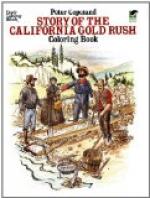Since almost all the houses in San Francisco were light frames of wood covered with cloth or paper, and since there was no fire department, there were six great fires, each of which nearly burnt up the town. The only way to stop the flames was to pull down houses or to blow them up with gunpowder. But almost before the ashes of one fire had cooled, wooden, cloth and paper buildings would cover whole blocks, to be burned again before long. The fifth great fire, in ’51, destroyed a thousand houses and ten million dollars’ worth of property in a night. One warehouse containing many barrels of vinegar was saved by covering the roof with blankets dipped in the vinegar, as no water could be had. The iron houses that had been thought fire-proof were of no use. Men who stayed in them found too late that the iron doors swelled with the heat and could not be opened, so that those within were smothered to death.
Then people began to guard against such fires by building new houses of stone or of brick. The sixth great fire destroyed most of the wooden buildings in the business part of the city. After that, with two or three fire companies and engines and better houses, people no longer dreaded the fire-bell. Water was piped into the city from Mountain Lake, and there was plenty for all purposes.
[Illustration: SEAL ROCKS, SAN FRANCISCO.]
[Illustration: THE NEW CLIFF HOUSE, SAN FRANCISCO.]
So the city grew larger, until in ’53 there were fifty thousand people of all races and countries who called San Francisco home. Chinese and Japanese, the Mexican, African, Pacific Islander, Greek, or Turk, or Malay elbowed crowds of Americans, English, French, and Germans. It was said that any foreigner could find in the city those who spoke his language, and that gold was a word all knew.
The largest yield of gold from the mines was in ’53, and the next year was a poor year for the miners. They bought fewer goods in San Francisco, and the storekeepers found business falling off. Too many houses had been built, so rents went down and times were hard for a year or two. In ’55 there were many bank failures, and business troubles of all kinds made the people restless, and roughs and murderers carried a strong hand. Then the “law and order party,” as the vigilance committee was at that time called, began once more the task of punishing those who robbed or killed. A list of criminal offenders was made out, and such were sent away from the state. One excellent result of the vigilance committee’s labors was that a “people’s party,” as it was called, chose the best men to govern the city, and for years after peace and order were in San Francisco.
In ’54 the city was lighted with gas for the first time, at a cost of fifteen dollars a thousand feet. In that year also the mint began to coin money from gold-dust, making five, ten and twenty-dollar pieces. Lone Mountain Cemetery was laid out about this time, and the old Yerba Buena graveyard, where the City Hall now stands, was closed.




